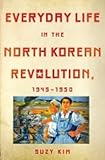Everyday Life in the North Korean Revolution, 1945-1950 / Suzy Kim.
Material type: TextPublisher: Ithaca, NY : Cornell University Press, [2013]Copyright date: ©2016Description: 1 online resource (328 p.) : 13 halftones, 25 tables, 1 mapContent type:
TextPublisher: Ithaca, NY : Cornell University Press, [2013]Copyright date: ©2016Description: 1 online resource (328 p.) : 13 halftones, 25 tables, 1 mapContent type: - 9780801452130
- 9780801469367
- 951.9304 23
- online - DeGruyter
- Issued also in print.
| Item type | Current library | Call number | URL | Status | Notes | Barcode | |
|---|---|---|---|---|---|---|---|
 eBook
eBook
|
Biblioteca "Angelicum" Pont. Univ. S.Tommaso d'Aquino Nuvola online | online - DeGruyter (Browse shelf(Opens below)) | Online access | Not for loan (Accesso limitato) | Accesso per gli utenti autorizzati / Access for authorized users | (dgr)9780801469367 |
Frontmatter -- Contents -- Illustrations -- Tables -- Acknowledgments -- Introduction -- 1. Revolutions in the Everyday -- 2. Legacies -- 3. Three Reforms -- 4. The Collective -- 5. Autobiographies -- 6. Revolutionary Motherhood -- 7. " Liberated Space " -- Conclusion -- Appendix -- Notes -- Index
restricted access online access with authorization star
http://purl.org/coar/access_right/c_16ec
During the founding of North Korea, competing visions of an ideal modern state proliferated. Independence and democracy were touted by all, but plans for the future of North Korea differed in their ideas about how everyday life should be organized. Daily life came under scrutiny as the primary arena for social change in public and private life. In Everyday Life in the North Korean Revolution, 1945-1950, Kim examines the revolutionary events that shaped people's lives in the development of the Democratic People's Republic of Korea. By shifting the historical focus from the state and the Great Leader to how villagers experienced social revolution, Kim offers new insights into why North Korea insists on setting its own course.Kim's innovative use of documents seized by U.S. military forces during the Korean War and now stored in the National Archives-personnel files, autobiographies, minutes of organizational meetings, educational materials, women's magazines, and court documents-together with oral histories allows her to present the first social history of North Korea during its formative years. In an account that makes clear the leading role of women in these efforts, Kim examines how villagers experienced, understood, and later remembered such events as the first land reform and modern elections in Korea's history, as well as practices in literacy schools, communal halls, mass organizations, and study sessions that transformed daily routine.
Issued also in print.
Mode of access: Internet via World Wide Web.
In English.
Description based on online resource; title from PDF title page (publisher's Web site, viewed 02. Mrz 2022)


